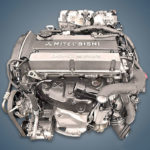2.0-liter Mitsubishi 4G63T turbo gasoline engine was produced from 1987 to 2007 and was installed in many of the company’s sports models such as the Lancer Evolution and Galant VR-4. Some modifications of this unit for the English market developed 411 hp and 481 Nm.
The 4G63T is considered truly iconic by motorists around the world because of the limitless number of modifications, the choice of spare parts, an excellent resource, durability and maintainability. But the main thing is the fantastic possibilities of forcing and tuning the engine, which is used not only by “garage” craftsmen, but also by branded ateliers. The engine was produced in 1987-2007, has a resource exceeding an average of 300 thousand km and a tuning potential exceeding 1000 hp.
The 4G6 family also includes engines: 4G61, 4G62, 4G63, 4G64, 4G67 and 4G69.
The engine was installed on:
- Mitsubishi Eclipse 1G in 1990 – 1994;
- Mitsubishi Eclipse 2G in 1994 – 2000;
- Mitsubishi Galant VR-4 in 1987 – 1992;
- Mitsubishi Lancer EVO in 1992 – 2007;
- Mitsubishi Outlander Turbo in 2002 – 2006;
- Mitsubishi RVR Hyper Sports in 1994 – 1999.
Specifications
| Production years | 1987-2007 |
| Displacement, cc | 1997 |
| Fuel system | injector |
| Power output, hp | 195 – 270 (1 Gen) 276 – 280 (2 Gen) 264 – 291 (3 Gen) |
| Torque output, Nm | 278 – 309 (1 Gen) 330 – 373 (2 Gen) 343 – 407 (3 Gen) |
| Cylinder block | cast iron R4 |
| Block head | aluminum 16v |
| Cylinder bore, mm | 85 |
| Piston stroke, mm | 88 |
| Compression ratio | 7.8 – 9.0 (1 Gen) 8.8 (2 Gen) 8.8 (3 Gen) |
| Features | intercooler |
| Hydraulic lifters | yes |
| Timing drive | belt |
| Phase regulator | no (1 Gen) no (2 Gen) MIVEC, option (3 Gen) |
| Turbocharging | yes |
| Recommended engine oil | 5W-30 |
| Engine oil capacity, liter | 5.0 |
| Fuel type | petrol |
| Euro standards | EURO 2/3 (1 Gen) EURO 3 (2 Gen) EURO 3/4 (3 Gen) |
| Fuel consumption, L/100 km (for Mitsubishi Lancer Evolution 2005) — city — highway — combined |
14.6 8.2 10.6 |
| Engine lifespan, km | ~300 000 |
| Weight, kg | 170 |
Disadvantages of the 4G63T engine
- The use of low-quality oil quickly affects the condition of the balance shafts;
- The wedge of the shaft leads to a break in their belt, it falls under the timing belt and the end of the motor;
- Vibrations of the balancers reduce the resource of the pillows of the power unit by several times;
- Dirty idle control or throttle causes floating speed;
- Many owners are facing cracked intake and exhaust manifolds.






